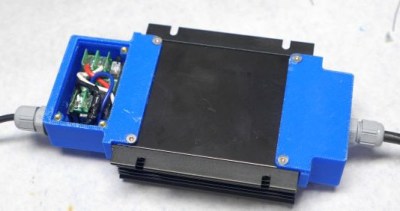If you’ve travelling via bike, you’ll know there’s a certain advantage to packing light. But what if you need to take your beefy desktop-replacement laptop with you on one of these trips? These power hungry machines can’t go far without their chargers (or a place to plug them in), which generally makes them poor traveling companions.
Luckily, [transistor-man] came up with a solution to this particular problem by reusing his e-bike’s battery pack as a mobile power source for his Lenovo laptop. The energy demands of this particular computer are too high for USB-C Power Delivery, and as such, he had to hack up a way to feed it 20 volts DC via its proprietary square power connector. His bike’s battery puts out between 30 and 42 VDC depending on charge, so at least on paper, it should work out fine.
 With a bit of experimentation, [transistor-man] determined that the peak current during his laptop’s charge cycle was 8 amps, or 160 watts. He reasoned there was no way it could continuously operate at such high current, so he estimated the could get away with a DC-DC converter that would accept the voltage range of his battery and output a constant voltage with around 150 watts of power. As it so happens, these are fairly common on the second hand market, and he picked one up to be the heart of his new gadget.
With a bit of experimentation, [transistor-man] determined that the peak current during his laptop’s charge cycle was 8 amps, or 160 watts. He reasoned there was no way it could continuously operate at such high current, so he estimated the could get away with a DC-DC converter that would accept the voltage range of his battery and output a constant voltage with around 150 watts of power. As it so happens, these are fairly common on the second hand market, and he picked one up to be the heart of his new gadget.
One potential issue was that the converter he bought normally outputs 24 V. Luckily, he didn’t need to add another regulator into the system, as consulting with the datasheet showed the output voltage could be adjusted with nothing more exotic than a resistor tacked onto an external trim terminal. He then designed 3D printable caps for either side of his converter, one to cover the terminals, and another to hold a handy wattmeter from Adafruit. Now that the core components are settled, there’s no reason [transistor-man] couldn’t adapt his creation for other devices that need some extended runtime.
















To be clear the resistor here is just to set the output voltage on the converter. The resistor itself is not handling any load current (thankfully).
That is a remarkably detailed build log and a really fun read
Thanks for the kind words! Glad you enjoyed the writeup!
Nice work and documentation.
I use these trigger modules from China to dump 20v/5a into my devices that don’t directly support USB C charging though. $12.99 for 6.
6 Pack MELIFE Type-C USB-C PD 20V DC Fixed Voltage Power Trigger Module 5A Type-C Female Input Module https://a.co/d/eJZzmWM
There are variants that allow you to solder a jumper to change the output voltage too.
This is a most excellent write up. I should absolutely make a version of this for my scooter so I can be the ultimate laptop workstation road warrior. :D
I did similar but reusing the FETs and current sensing in VESC4-based motor controller for driving the coil. Not sure it was a smart choice, because the motor controller operates at 50 kHz so I ended up needing a much larger coil and capacitors compared with adding a 500 kHz capable FET and DC-DC controller. I contemplated using the motor as the coil, but didn’t go that far :)
On the plus side it also works as boost input in reverse, so I can charge the battery from any lower voltage source.
A neat power bank build for powering high-power loads. But most laptops do not really need this much power. There are cheap USB-C voltage trigger modules which allow you to use any USB-C PD supply as a general purpose power source. 65W output is usually enough for most laptops.
As for that Lenovo, we are likely talking about a higher-end machine with a discrete GPU (that is, a low-power desktop replacement). Most laptops do not need over 100W of power and will happily charge off of USB-C source as long as you can find a way to get them connected to that source, either directly or using a trigger board with an adapter.
I did try out the USB-PD trigger modules (100w) with the dewalt 100W adapter and It was so close, it appears the charge-rate for this particular machine is nominally 90W when the internal battery is low, so you end up over-running 100W fairly quickly, Its likely this would work if you had started out with just laptop, not laptop + charging.
a laptop with a 10+ hour battery is less than $200 these days
just sayin
Laptops in that price range are almost always Chromebooks with soldered in, nonupgradeable RAM. No thank you.
Not exactly with “desktop replacement” performance though.
for sure!
i love both these replies and i marvel at the diversity in experience.
i personally haven’t wanted a faster or RAM-ier laptop in at least 13 years. the modern CPUs that deliver 2010 desktop performance at cellphone levels of power consumption are just an absolute miracle and i couldn’t find a use for more power in my lap if i tried.
can’t think of anything except web browsers and eclipse that have kept pace with CPU capacity through the teens